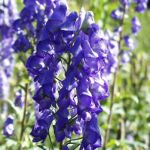| Common Name: |
Sichuan Aconite |
| Other Names: |
Azure Monkshood |
| Botanical Name: |
Aconitum carmichaelii syn. A. fischeri |
| Genus: |
Aconitum |
| Family: |
Ranunculaceae |
| Cultivation: |
Deep, moisture-retentive soil in shade. Plants will also thrive in a sunny position if the soil is suffiently damp throughout the growing season; they do not flower well in dry conditions. Remove dead flower heads to encourage a second crop of flowers. Aconitums should be sited out of the reach of small children and animals, since even very small amounts can cause poisoning. Taller species need staking. |
| Propagation: |
By division when dormant; by seed sown in spring. |
| Harvest: |
Plants are lifted in autumn and young, thick roots are removed before replanting. Roots are processed professionally for use in decoctions, liniments and tinctures. |
| Warning: |
All parts of aconitums are highly toxic if eaten and may cause systemic poisoning if handled. Gloves should always be worn when handling, to avoid absorption of toxins through the skin.
For use by qualified practitioners only. Medicinal use is subject to legal restrictions in some countries. |
| Native Region: |
C and W China |
| Height: |
1.5-1.8cm (5-6ft) |
| Width: |
30-40cm (12-16in) |
| Varieties: |
Arendsii syn. Arends
Description:Larger than the species, and flowers later
Kelmscott
Description: Has lavender-blue flowers in autumn
Height: 1.2m (4ft)
Width: 30cm (12in) |
| Hardiness: |
Z3-7 |
| Parts Used: |
Roots |
| Properties: |
A sedative, painkilling herb that stimulates the heart and kidneys, and has diuretic and anti-rheumatic effects. |
| Medicinal Uses: |
Internally as a restorative following shock and trauma, for yang energy weakness, and in chronic osteo-arthritis. Dosage is critical, excess causing numbness of lips, tongue, and extremities, vomiting, breathing difficulties, lowering of pulse rate and blood pressure, coma, and death. Not given to pregnant women or patients with severe debilitation. Externally for rheumatism and arthritis, headache, and as a local anesthetic. |
| Bibliography: |
Encyclopedia of Herbs by Deni Brown Copyright © 1995, 2001 Dorling Kindersley Limited. pg 96.
|

